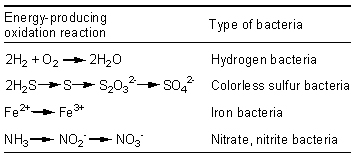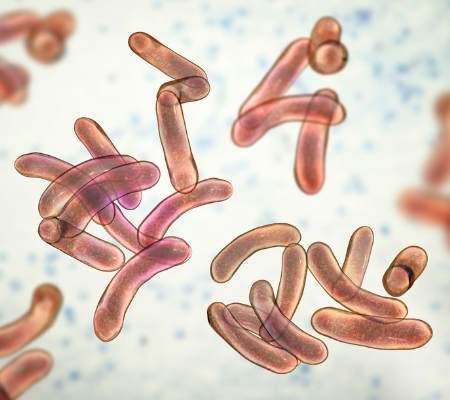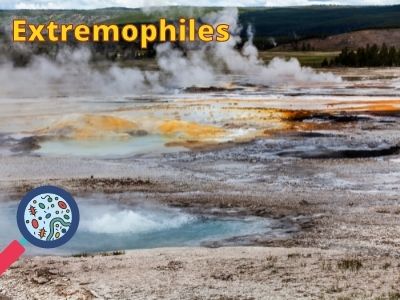Most bacteria get their nutrients by breaking down organic matter from things that were alive at some point, which classifies them as heterotrophs. This includes the bacteria in the soil and those that make us sick.
This is effectively classifying most bacteria consumers or decomposers. And these bacteria are immensely important for our ecosystems.
Other bacteria, such as cyanobacteria, are autotrophs and therefore able to obtain their energy without eating other organisms – in the case of cyanobacteria and other photosynthetic bacteria, they get their energy from the sun.
In contrast to photosynthetic bacteria, chemosynthetic bacteria do not use photosynthesis to obtain their energy from the sun but are able to use the chemical energy stored within inorganic compounds to release energy!
Chemosynthetic bacteria are considered autotrophic as they most often get their carbon from carbon dioxide.
However, although more rare, chemosynthetic bacteria can (at least in theory) also be heterotrophs, if they use chemical energy but get their carbon from organic compounds – but then they are usually not considered fully chemosynthetic anymore!
We will dive more into exactly what these bacteria do and where they are found in the following!
What are chemosynthetic bacteria?
Chemosynthetic bacteria are a type of bacteria that do not break down organic matter in order to obtain energy. Instead, they use inorganic chemicals from the environment to produce energy and build organic molecules.
Chemosynthetic organisms are also known as chemolithotrophs.
Rather than feeding on others, chemolithotrophs use a process known as chemosynthesis, which is the conversion of inorganic molecules into organic molecules that they build their cellular components from.
The inorganic molecules consumed for energy by chemosynthetic bacteria would usually be iron or hydrogen-based such as ammonia (denitrifying bacteria) or hydrogen sulfide (sulfur bacteria) and their source of carbon is carbon dioxide. This is what makes chemosynthetic bacteria fully self sufficient or autotrophic.

They can harvest energy, where there are no other sources of energy forms such as the sun and other living organisms. Therefore they are often found in extreme environments such as deep-sea vents, volcanic craters, and hot springs.
Because chemosynthetic bacteria are able to live in environments where photosynthesis is not possible, it makes them the main primary producers.
Chemosynthetic bacteria are very important for ecosystems that lack photosynthesis and do not support many other lifeforms, such as in the darkness of the deep ocean!
Indeed, other organisms in these deep-sea environments are highly dependent on chemosynthetic bacteria for their survival, and some even feed on them as their sole food source.
Giant tube worms obtain their energy from chemosynthetic bacteria!
Giant tube worms live in ocean depths that do not receive any sunlight or other forms of energy from above. Therefore, they feed solely on the carbon built by chemosynthetic bacteria to survive.
The chemosynthetic bacteria live inside the tubes of giant tube worms and obtain energy for themselves by breaking down sulfur compounds found nearby hydrothermal vents. The worms absorb this energy from the chemosynthetic bacteria by absorbing their organic building blocks when they die!
The relationship between giant tube worms and chemosynthetic bacteria is beneficial for both organisms. The bacteria get a place to live and the worms get the energy to survive! Win-win!
Can chemosynthetic bacteria also be heterotrophs?
Most bacteria and animals obtain their energy and carbon by breaking down the organic molecules of other living organisms, which defines them as heterotrophs, but chemosynthetic bacteria are almost always autotrophs because they are “self-feeding” via carbon dioxide.
If complex organic molecules were abundant, they could also get their energy by performing fermentation without the need for inorganic molecules – so why do chemosynthetic bacteria prefer inorganic molecules?
Chemosynthetic bacteria, especially those living in extreme environments, use carbon dioxide as their carbon source likely because there are simply too few living organisms around to provide more complex organic molecules and because it is a bad strategy to compete with heterotrophs for food.
In addition, inorganic molecules are often better electron acceptors than organic ones, and the “leftovers” of fermentation (such as ethanol and organic acids) are often toxic and will be eaten by competing bacteria!
An example of heterotrophic chemosynthetic bacteria are the bacteria of the Desulfovibrio genus.

These bacteria were first thought to be entirely autotrophic and only able to get their carbon from carbon dioxide, however, it was later realized that they do in fact grow even better with the addition of organic molecules from yeast extract.
Another organisms that suffers from a similar identity crisis are the Euglena protists that can function as both plants and animals and obtain their energy by photosynthesis.
However, when these examples occur, the discussion of whether such organisms are autotrophs or heterotrophs starts!
One could argue that they are in fact still autotrophic as this is their “simplest” or most fundamental mode of carbon acquisition is in fact autotrophy, but the Desulfovibrio bacteria mentioned in the example above, are now referred to as heterotrophs rather than autotrophs.
Are chemosynthetic bacteria decomposers?
Chemosynthetic bacteria are either autotrophic heterotrophic and can therefore also be decomposers as if they get their energy from organic matter. However, if they get their carbon from carbon dioxide, they cannot be classified as decomposers.
Decomposers are defined by their ability to eat the leftovers of other living organisms, which classifies them as heterotrophs.
Most chemosynthetic bacteria do not eat other organisms or their decaying bodies, so they are not decomposers or consumers but rater producers.
However, some chemosynthetic bacteria obtain their energy from sulfur released from the bones and carcesses rottening away in the deep sea, and are therefore involved in the recycling of dead materials into organic materials that can be utilized by the higher trophic layers.
And whereas some chemosynthetic bacteria are primary producers (like plants) because they can convert inorganic molecules (like CO2) directly into organic molecules for other organisms to feed on, others do eat organic compounds to obtain their carbon building blocks.
Chemosynthetic bacteria that obtain their energy from inorganic compounds but have something else than carbon dioxide as their carbon source can be considered decomposers if they feed on dead animal or plant matter.
Today, most microbes and animal organisms on earth are indeed heterotrophs, breaking down the organic matter left by other dead organisms like animals and plants!
In that sense, chemosynthetic bacteria are at the very bottom of the food chain/pyramid because they lay the very important foundation for heterotropic life on earth to emerge and evolve into all the organisms we know today!
This function as decomposers makes microorganisms like bacteria and fungi the most important “cleaners” of the ecosystems in the world today!
How are chemosynthetic and photosynthetic bacteria different?
The difference between chemosynthetic bacteria and photosynthetic bacteria is that chemosynthetic bacteria use chemosynthesis to obtain energy and photosynthetic bacteria use photosynthesis.
The main difference between chemosynthesis and photosynthesis is that photosynthesis uses sunlight to produce food, while chemosynthesis uses inorganic chemicals from the environment.
In photosynthesis, energy from the sun is used to produce glucose from carbon dioxide and water. In chemosynthesis, inorganic compounds are broken down to release energy.
This energy can be used to power the cell or to produce ATP, which is a molecule that cells use for energy.

Another differences are that many chemosynthetic bacteria are extremophiles, most are anaerobic and many live in complete darkness!
How did primitive heterotrophs produce energy?
In the beginning, there was only chemosynthesis, but how did heterotrophs come into existence?
It is very likely that chemosynthetic bacteria and archaea are the organisms resembling the first life on earth the most!
Chemosynthetic bacteria used their energy to grow and thereby form new masses of organic molecules that other organisms evolved to feed on – these organisms were the first heterotrophs!
The first primitive heterotrophs were most likely bacteria that lived from the first organic compounds produced by the chemosynthetic bacteria. They were anaerobic as no oxygen was present on earth back then.
Because of the lack of oxygen, they would need to use another electron acceptor, such as sulfur, for anaerobic respiration to take place.
Alternatively, the first primitive heterotrophs could also have used fermentation to obtain energy.
Fermentation is the process where the metabolized organic compound is also used as the final electron acceptor, therefore producing waste products such as ethanol, methane, or lactic acid.
As photosynthesis came along, oxygen started filling the atmosphere, which made it easier for heterotrophs to put their electrons from respiration onto the highly electron-craving oxygen molecules rather than larger organic compounds.
Are archaebacteria autotroph or heterotroph?
Archaea can be both autotrophic and heterotrophic. Archaea are very metabolically diverse, so they can use a variety of different methods to produce energy.
Some archaea use chemosynthesis as autotrophs, while others consume organic matter for energy and are therefore heterotrophs. Archaebacteria are often classified as Methanogens as they produce methane as part of their metabolism.
Archaea can also perform a primitive form of photosynthesis based on Mg-tetrapyrrole–based complexes. This type of photosynthesis is different from the one used by plants, and it does not produce oxygen gas.




